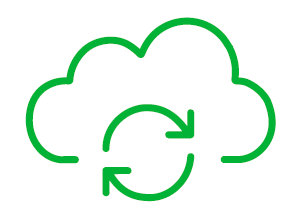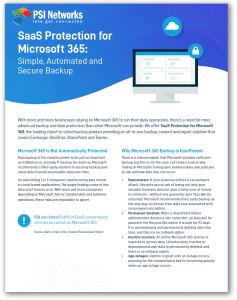Your Data. Your Responsibility.

The Big Office 365 Misconception
One of the most business-friendly innovations in recent years has been the proliferation of cloud apps like Google Apps and Office 365. These Software as a Service (SaaS) solution apps have fundamentally changed the way we do business, enabling companies to take advantage of economies of scale, reduce infrastructure costs, and expand the boundaries of a cubicle.
Many assume back-ups are not required with Office but this is wrong. Microsoft takes care of quite a bit, and provides a great service for their customers. However, Microsoft’s primary focus is on managing the Office 365 infrastructure and maintaining uptime to your users. They are empowering YOU with the responsibility of your data. The misconception that Microsoft fully backs up your data on your behalf is quite common, and without a shift in mindset, could have damaging repercussions when this responsibility is left unattended. Ultimately, you need to ensure you have access to, and control over, your Exchange Online, SharePoint Online,OneDrive for Business and Microsoft Teams data.
Storing data in cloud applications is far safer than storing data on most on-premise storage systems. However, “safe” does not equal "invulnerable" In fact, one third of SaaS users report losing data in the cloud. Yes, the cloud is safe, but it’s not infallible and today’s cloud vendors lack the incentive to point out their vulnerabilities. This is where PSI can help!
The cloud, when left alone, is very safe. Google, and Microsoft do a great job of ensuring the data is protected. And yet, data loss happens every day. So who’s at fault? The single leading (and unpreventable) cause of data loss in the cloud is end user error. This will always be an achilles heel of the cloud until software can discern between an intentional and unintentional command.
Other common culprits? Intentional deletion by disgruntled employees, hackers, external app errors (data corruption via syncing/over-writing), and other causes described below. When data loss occurs, it’s often not the fault of Google and Microsoft. With a cloud-to-cloud backup solution, businesses own the data from the moment a backup begins without limits around point-in-time.
SaaS protection delivers backup, search, restore, and export to:
Microsoft 365
- Exchange
- Tasks
- OneDrive
- SharePoint
- Teams
Google Workspace
- Gmail
- Google Docs
- Calendar
- Contacts
- Shared Drives
Starter Plans
Here is some simple pricing for PSI's Office 365 backup solution. Both options include backups of email (shared mailboxes included), Teams, OneDrive and SharePoint data.
- Time-Based Retention (TBR): Only $3.75 per mailbox per month (1 year term)
- Infinite Cloud Retention (ICR): Only $4.10 per mailbox per month (1 year term)

The Real Cost of Outages
SaaS applications are always available and while highly reliable, outages do occur. In October 2020 alone, Microsoft 365 had three significant outages that impacted businesses worldwide. Last year, a massive Google outage affected nearly one billion Gmail, G Suite, and YouTube users.
Outages and slow restore times aren’t just an inconvenience. When businesses can’t access important business data, productivity falls and revenue is impacted. Creating backups that are independent of a SaaS provider’s cloud servers is the only way to ensure access to essential files in the event of an outage.
6 Reasons Why Backing up Office 365 is Critical
Accidental Deletion

If you delete a user, whether you meant to or not, that deletion is replicated across the network, along with the deletion of their personal SharePoint site and their OneDrive data.
Native recycle bins and version histories included in Office 365 can only protect you from data loss in a limited way, which can turn a simple recovery from a proper backup into a big problem after Office 365 has geo-redundantly deleted the data forever, or it has fallen out of the retention period.
There are two types of deletions in the Office 365 platform, soft delete and hard delete. An example of soft delete is emptying the Deleted Items folder. It is also referred to as “Permanently Deleted.” In this case, permanent is not completely permanent, as the item can still be found in the Recoverable Items mailbox. A hard delete is when an item is tagged to be purged from the mailbox database completely. Once this happens, it is unrecoverable, period.

Retention Policy Gaps and Confusion
The fast pace of business in the digital age lends itself to continuously evolving policies, including retention policies that are difficult to keep up with, let alone manage. Just like hard and soft delete, Office 365 has limited backup and retention policies that can only fend off situational data loss, and is not intended to be an all-encompassing backup solution.
Another type of recovery, a point-in-time restoration of mailbox items, is not in scope with Microsoft. In the case of a catastrophic issue, a backup solution can provide the ability to roll back to a previous point-in-time prior to this issue and saving the day.
With an Office 365 backup solution, there are no retention policy gaps or restore inflexibility. Short term backups or long-term archives, granular or point-in-time restores, everything is at your fingertips making data recovery fast, easy and reliable.

Internal Security Threats
The idea of a security threat brings to mind hackers and viruses. However, businesses experience threats from the inside, and they are happening more often than you think. Organizations fall victim to threats posed by their very own employees, both intentionally and unintentionally.
Access to files and contacts changes so quickly, it can be hard to keep an eye on those in which you’ve installed the most trust. Microsoft has no way of knowing the difference between a regular user and a terminated employee attempting to delete critical company data before they depart. In addition, some users unknowingly create serious threats by downloading infected files or accidentally leaking usernames and passwords to sites they thought they could trust.
Another example is evidence tampering. Imagine an employee strategically deleting incriminating emails or files — keeping these objects out of the reach of the legal, compliance or HR departments.

External Security Threats
Malware and viruses, like ransomware, have done serious damage to organizations across the globe. Not only is company reputation at risk, but the privacy and security of internal and customer data as well.
External threats can sneak in through emails and attachments, and it isn’t always enough to educate users on what to look out for — especially when the infected messages seem so compelling. Exchange Online’s limited backup/recovery functions are inadequate to handle serious attacks. Regular backups will help ensure a separate copy of your data is uninfected and that you can recover quickly.

Legal and Compliance Requirements
Sometimes you need to unexpectedly retrieve emails, files or other types of data amid legal action. Something you never think it is going to happen to you until it does. Microsoft has built in a couple safety nets, (Litigation Hold) but again, these are not a robust backup solution capable of keeping your company out of legal trouble. For example, if you accidentally delete a user, their on-hold mailbox, personal SharePoint site and OneDrive account is also deleted.
Legal requirements, compliance requirements, and access regulations vary between industries and countries, but fines, penalties and legal disputes are three things you don’t want on any to-do list.

Managing Hybrid Email Deployments and Migrations to Office 365
Organizations that adopt Office 365 typically need a window of time to serve as a transition window between on-premises Exchange and Office 365 Exchange Online. Some even leave a small portion of their legacy system in place to have added flexibility and additional control. These hybrid email deployments are common, yet pose additional management challenges.
The right Office 365 backup solution should be able to handle hybrid email deployments, and treat exchange data the same, making the source location irrelevant. Furthermore, you should be able to store the data anywhere you choose, whether on premises, in cloud object storage such as AWS S3 or Azure Blob, or with a managed service provider.
Call PSI Today
Call PSI today at 613-747-5018 to learn more about Office 365 Backup and and how to take control of security gaps you may not have been aware of before. We’re here to help.


